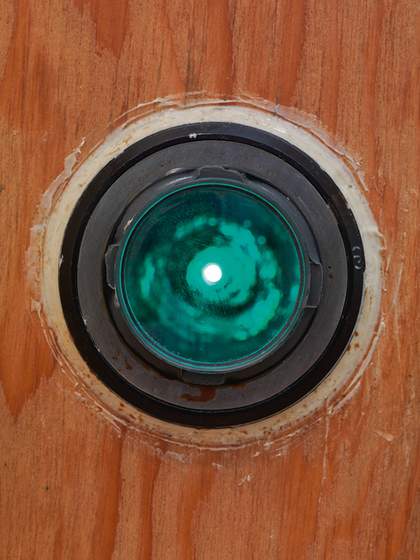After Mike Kelley’s premature death sometime between 31 January and 1 February 2012, a spontaneous roadside memorial to the artist soon appeared near his studio in the suburbs of Los Angeles. Perhaps inevitably, it featured an accumulation of soiled stuffed toys, hand-knitted blankets and garish knick-knacks of the kind Kelley often used in the sculptures and installations that, since the late 1980s, have become his most recognisable works.
Although these inherently sentimental and highly symbolic objects surely lend themselves to such a heartfelt homage, there is a tragic irony in the shape this outpouring of grief has taken. Kelley often expressed frustration at his repute as ‘the stuffed toy artist’, and the latter half of his career ostensibly developed in reaction to what he saw as a persistent misunderstanding of his work – primarily made as deadpan commentary on class aesthetics and materialist rituals, yet invariably interpreted as an expression of nostalgia and repressed trauma. Eventually he recognised in this tendency a stubborn obsession with pop psychoanalysis, a true mythology of the twentieth century using watered-down Freudian notions, such as that of ‘repressed memory syndrome’, with the same naive logic of an allegorical fable.
Indeed, one of Kelley’s central preoccupations throughout his career was with the ways in which meaning can be distorted, conditioned and reconfigured into different forms: through puns and figures of speech, unexpected twists or juxtapositions, but also as the product of belief systems or cultural biases. Popular culture interested him precisely because of its powerful influence on perception, as an acquired structure reducing all phenomena to familiar categories with the least critical effort.
Take as an example the installation Channel One, Channel Two and Channel Three from 1994. Despite its apparent simplicity (and its lack of stuffed toys), this work opens up a rich network of references typical of Kelley’s whole expressive language. With its three oblong plywood boxes on sawhorses, it is exemplary of his use of vernacular and craft materials, as well as of sound and light elements hinting at sci-fi, psychedelia and altered states of mind in the collective unconscious. Moreover, it has a double function as a potential mind-conditioning tool: it encourages interaction by luring the viewer towards its peepholes, and in itself it looks like a makeshift simulator for psychotropic experiences, with its tin foil interiors lit up by yellow, blue and red light bulbs, accompanied by a droning soundtrack.

Detail of Mike Kelley's Channel One, Channel Two and Channel Three 1994 at Tate Modern
This do-it-yourself aesthetic is a recurring feature of Kelley’s sculptures, which links back to his early series of birdhouses of 1978, intended to subvert the extreme formal reductions of Minimal and Conceptual art, then prevalent at CalArts where Kelley was a graduate student, by using what he saw as the blankest, most invisible type of object-making: amateur crafts.
In the first half of the 1990s Kelley created a number of works which took the form of stripped-down plywood structures resembling crude DIY projects. Orgone Shed 1992, for example, is a garden shed adapted for use as a new age self-help device known as an orgone accumulator. This simple wooden cabin lined with layers of glass wool, steel wool and iron was designed in 1940 by controversial psychoanalyst Wilhelm Reich to harness a cosmic energy he called orgone radiation – part libidinal force, part physical entity. Reich was also a zealous advocate for ufology – another obsession of Kelley’s obliquely referenced in Channel One, Channel Two and Channel Three.
The use of primary colours in the latter is derived from the ‘push/ pull’ spatial doctrine of Abstract Expressionist painter Hans Hofmann, force-fed to the young Kelley at the Ann Arbor School of Art & Design. But vivid colours and ‘tunnels of light’ also feature heavily in alien abduction testimonies as overwhelming sensorial experiences, contrived just like the illusion of movement and space in Hofmann’s writings (and, for Kelley, equally traumatic).
Psychedelia and the cult of alien contacts naturally converged into the hallucinatory imagery of post-war science fiction, as well as in the electric distortions and synthesised sounds of the space rock genre. But the strange, disembodied reverberations allowed by sound technology after the invention of the phonograph have evoked in the popular imagination not just aliens, but all sorts of supernatural beings. The noise track of Channel One, Channel Two and Channel Three – which could be interpreted as the tinnitus of an abductee or an extraterrestrial signal hidden in radio interference – also resembles the recordings of “spirit voices” on tape, known as electronic voice phenomena, popularised in the 1970s by self-appointed ‘spiritualist scientist’ Konstantin Raudive, another recurring character in Kelley’s œuvre.
This tangle of references in Channel One, Channel Two and Channel Three should not be interpreted as a celebration of the complexities of popular culture. Kelley’s works often hijack familiar sign systems in order to trigger reactions and point at interpretive mechanisms often taken for granted. In this case, the gullibility of UFO and supernatural phenomena enthusiasts is revealed as a mundane construction of plywood and tin foil with coloured light bulbs and some background noise: a set of objects on to which we project meaning.

